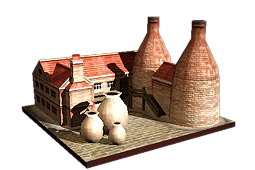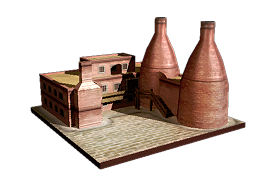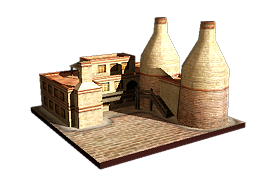Ceramics Factory (ETW building)
| Ceramics Factory | |||||||
|---|---|---|---|---|---|---|---|
| Category: | Pottery Industry | ||||||
| Level: | 3 | ||||||
| Turns to build: | 6 | ||||||
| Building cost: | 6000 | ||||||
| |||||||
| Requires | |||||||
| Kilns | |||||||
| Technology | |||||||
| Machine Tools | |||||||
A ceramics factory produces pottery on an industrial scale; each run produces an enormous batch of wares, without any real need for skilled potters.
The factory normally has a series of coal-fired kilns, so production can be more or less continuous. One kiln is filled with unfired wares while another is firing, a third is cooling, a fourth being carefully unpacked and so on. Coal is the fuel because charcoal is simply not available in the necessary quantities.
The pottery produced is both relatively cheap and of a consistently high quality: mass-produced standard designs add a touch of refinement to the life of the working classes, allowing them to own almost the same goods as their social betters. Relatively unskilled (and cheap) labourers produce these standard designs, as the production process has no need of individual creativity.
Josiah Wedgwood (1730-1795) was the most famous of the “industrial potters”, producing high quality goods at an affordable cost for the burgeoning middle classes. His ceramic designs – Queen’s Ware (1762), Black Basalt (1768) and Jasper (1774) – were famous for their style and beauty, and influence styles still in production today.



